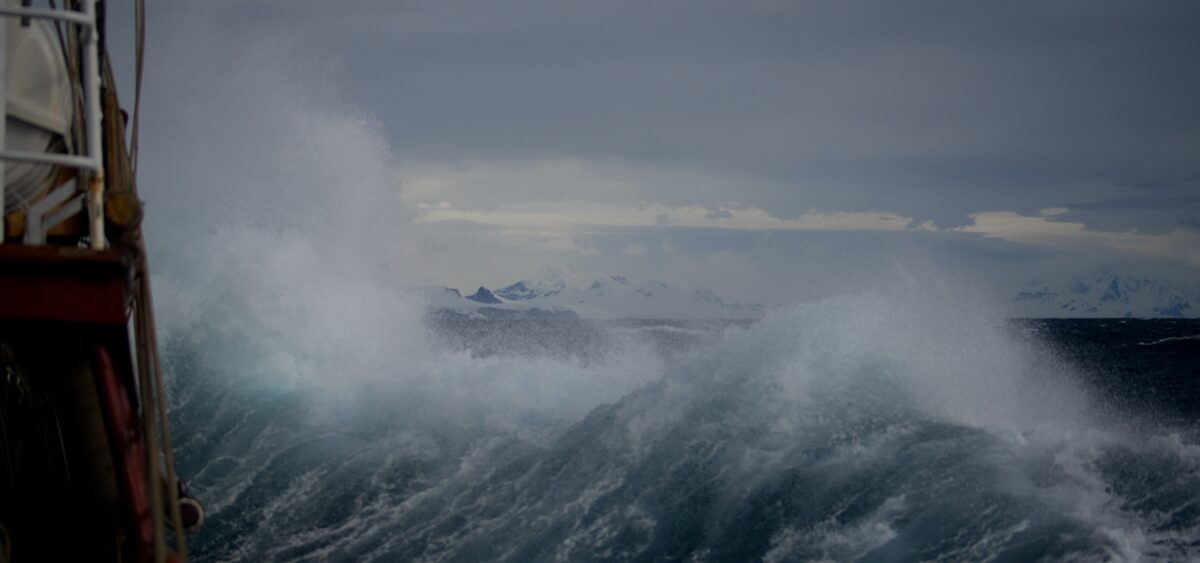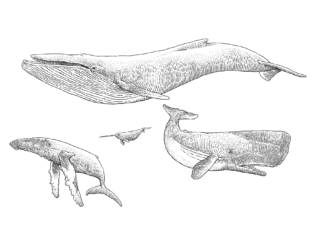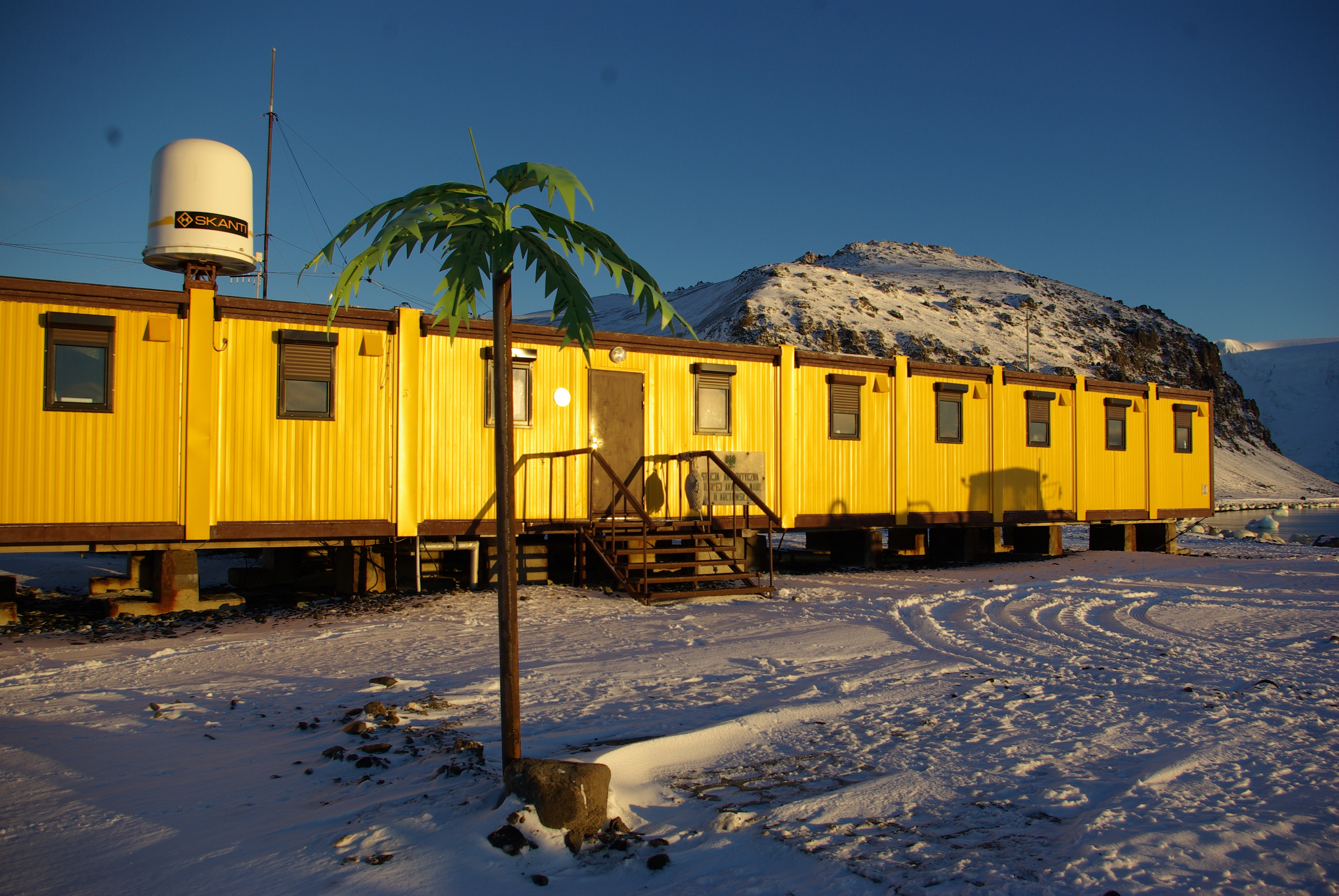
There’s no wind like that in the Antarctic—it can snatch up anything, even ocean water. Although it’s cold and sharp, it can also bring delight, laughter, and remind you that humans don’t call the shots in the world; nature does.
It was the second week of my first stay in the Antarctic. The wind was so strong that the roof of the research station would sometimes lift a few centimeters, allowing seaweed blown in from the sea to fall through the gap and into our soup. As he was enthusiastically gobbling up his dinner, my colleague—an experienced polar explorer—commented that he always wonders on which expedition the roof will finally fly away. Ten minutes later the roof was gone.
It’s windy practically everywhere on the planet’s southernmost continent. All it takes is a pressure difference to appear in the atmosphere. The pressure that is reported in weather forecasts measures the content of air in air. When it’s high, a given volume contains more air, and when it’s low there’s less. It gets windy where these two areas meet, because nature prefers things to be equal. It’s just like when two solutions are separated with a permeable membrane: they will attempt to equalize their concentrations. But winds will never settle down for good on a global scale, and atmospheric pressure will never equalize across the whole world. At any given moment, some parts of the globe are more heated than others, and warm air is lighter and less dense than cold air—it rises, creating new areas of low pressure. Of course, the mechanics of how gasses move around the Earth is much more complex, but the key point here is the incessant elimination of constantly emerging disturbances. It might seem that wind disturbs the balance, but in fact air rushes from place to place in order to restore it.
Across the planet, these moving masses of air exhibit certain regularities and in many areas winds have quite a predictable nature. There are seasons for tropical hurricanes, typhoons, and even Foehn winds in mountainous areas. Moreover, most winds—at least over open oceans—blow from west to east. This is related to the rotation of the Earth. Our planet rotates in an easterly direction, which is why everything happens earlier in the east. It’s where the sun rises above the horizon; noon in Kyiv is an hour earlier than in Warsaw, and in the Polish capital it’s an hour earlier than in London. If the Earth was observed from the direction of the pole star in the north, its rotation would appear counter-clockwise. The atmosphere sticks to the Earth’s surface, rotating along with it, which is what causes the western winds, aligned with the direction of the Coriolis force.
The World’s Windiest Passage
Although one can encounter regular, often very strong winds at all latitudes, there is only one place on the planet where they can really go wild. The southern parts of the largest oceans are the only area where one can circumnavigate the globe by sailing along one of the parallels and encounter no land. Therefore, winds blow here without meeting any obstacles.
The narrowest place in this swath of boundless ocean is the Drake Passage, which is 620 miles wide and stretches between Cape Horn (the southernmost end of South America) and the South Shetland Islands near the tip of the Antarctic Peninsula, somewhere between the latitudes of 55 and 61 degrees south. In this region, it isn’t only winds that move mostly from west to east. In the Earth’s crust, a relatively small tectonic plate called Scotia squeezes itself here between the Antarctic Plate and the South American Plate; it is located under the bottom of a sea of the same name (both were named in honor of the Scottish expedition ship). When tectonic plates push their way somewhere, other attractive effects—such as volcanoes, earthquakes, and uplifts—are joined by the warping of already existing continents. This is why the very tip of South America and the Antarctic Peninsula are tilted towards the east (in the past, they formed a continuous mountain range). This creates a gigantic funnel which adds extra speed and strength to the western winds from the Pacific.
The whole Antarctic Ocean is the world’s windiest area, but in the Drake Passage these winds are most highly concentrated. This is exactly the reason why sailors speak of passing Cape Horn “the wrong way,” which is from the Atlantic to the Pacific, against the dominating winds. That doesn’t mean the other way is the right one—it’s just a little bit less wrong.
In the Drake Passage, storms happen more often than elsewhere, but it’s not windy there all the time. I have traversed it around two hundred times and remember at least three crossings when the ocean was as smooth as silk. I’m ashamed to admit that when I last passed Cape Horn—on my favorite sailboat from Selma Expeditions—the weather was so calm that we had to turn on the engines because progressing under sail was impossible.
Petrels, Fulmars, Albatrosses
Sailors have been making use of the wind for a few millennia, but marine birds have been perfecting this art for many millions of years—it is no surprise that they have mastered it. Hence they’re most numerous precisely where it’s the windiest: around the Antarctic Ocean. Flying seems simple: if you have wings, you flap them and move in the air. However, the energy cost of that simple flapping increases along with the bird’s size. The avian masters of soaring over land—eagles, vultures, and storks—rely on thermal columns. Land heats up in the sun and in certain places this creates columns of rising air (it gets lighter as it warms up). These virtuosos of land flight have wide wings, similar to a paraglider, which are a great fit for catching these updraughts. However, these currents do not appear over the ocean, so big marine birds, like albatrosses and petrels, make use of the wind. Their wings are long and narrow like those of a glider plane (although in fact it is the other way around, since birds existed long before gliders). Their flight technique can be described as active gliding. The bird descends slowly with the wind, then veers suddenly just above the water, catches the wind, and rides it back up. The harder the wind blows, the easier it is to fly: an albatross has a completely different idea of good weather than humans do. Even if the wind is too strong and the birds temporarily lose control over their flight, there is no risk of crashing into anything above the ocean. The slightly smaller cousin of the albatross, the fulmar, even owes its name to words meaning “bad, dangerous sea,” because this is when they are the most active. The relationship between marine birds and strong winds is so strong that Inuit used to believe that fulmars actually caused storms.
During calm weather, albatrosses most often sit in the water and wait for better conditions, but when it’s windy and they glide, they use up exactly the same amount of energy as when they’re resting on the surface. Their wings have special blocking mechanisms, so spreading them wide takes little effort. For the first few years of their lives, albatrosses fly thousands of miles, never visiting land; later they pop onshore only to breed. Air is their element.
Wuthering Antarctic Heights
Whatever wind blows over the ocean also makes its way onto the southern lands. The Australian polar explorer Douglas Mawson wrote a book about one of his Antarctic expeditions and called it The Home of the Blizzard. Wind is the main weather factor regulating activities at the Henryk Arctowski Polish Antarctic Station, located on King George Island, one of the South Shetland Islands. The temperature isn’t too extreme on the islands (the lowest one on record was only -25.6°F), but the winds are strong there, especially in the spring and fall. During my second winter at the station, we had a day with more than a hundred gusts of wind exceeding 60 miles per hour. The fastest one was almost 180 miles per hour. By comparison, Hurricane Katrina had an average speed of around 140 miles per hour. During such winds, everything and anything will fly around, including stones and heavy Zodiac pontoon boats. Large metal storage containers roll around like toys, tractors jump in the air. At high school they teach that penguins don’t fly, but I’ll let you in on a secret—sometimes they do. I have seen a flying penguin. Admittedly, it was flying sideways and looked less than thrilled, but undoubtedly it was moving through the air. Following the penguin was the roof of our research station.
Sea water snatched up by the wind flies above the ocean waves (privately, in honor of a King Crimson song, I call this “dancing water”) and is often carried several hundred yards inland. Antarctica’s largest terrestrial animal, a midge of under a centimeter in length called Belgica antarctica—which didn’t really arrive on Antarctica, but made its way south along with the landmass in the course of the continental re-organization of tectonic plates—lost its wings in the course of evolution, because it makes absolutely no sense for a small insect to fly in these conditions. It’s much better to lurk among the mosses and lichens.
Wind makes the apparent temperature much lower than that displayed on the thermometer. I remember the morning after a night storm which had thrown sea water onto nearby rocks. Through the early hours it was so cold that the water froze on them before it could return to the sea. As a result, in the morning all the rocks looked like iced buns, tightly enveloped in snow-white ice. I was extremely keen to take a photo, but after I took my gloves off, fished around my backpack for the camera and turned it on, my hands were already so numb with cold that I couldn’t press the shutter release. I had to use my whole arm to move the stiff finger into place, as if it was a wooden prosthesis. The thermometer only showed 14°F, but because of the strong wind the apparent temperature was below -40°F.
Avalanches of Air
The Antarctic also has its spécialité de la maison: katabatic winds. Air that comes into contact with glaciers is cool, heavy, and dense. When a temperature gradient appears—that is, when air in other places is suitably warmer—gravity makes the cold air from the glaciers roll down in a violent gust, detectable only opposite the glacier itself. You can sail one hundred yards to the side and not feel the gust. Another characteristic of katabatic winds is that they don’t blow very high. The layer of air rapidly tumbling down the slope is only a dozen or so yards thick, so if a ship is anchored opposite the glacier, the lower decks will be ravaged by a gale, while the top one will be calm. Katabatic winds influence all activities in Antarctica. There are places where one must land around 5:00 a.m., when it’s still quiet. Later—as the sun heats up the air around 11:00 a.m.—a formerly peaceful spot is suddenly blasted by gusts that make it impossible to safely land a Zodiac boat on the shore.
Still, I really like Antarctic winds. At a speed of sixty miles per hour I can lean on the wind like the Polish ski jumper Adam Małysz in his starting position. The Antarctic wind also once prompted the formation of an exclusive club for people who aren’t exactly normal. One especially windy day, during my time as head of the Polish research station, its maintenance manager, the then deputy head of the Department of Antarctic Biology at the Polish Academy of Sciences, and I decided to check whether everything at the station was properly secured. All three of us had been friends for years and had a few Antarctic expeditions under our belts. We put on special emergency suits, because in these conditions normal Gore-Tex clothes don’t stand a chance: the wind means that every tiny gap makes itself felt. Our suits were designed so that you could fall into the sea and survive in the icy water. We put goggles on our faces and left, arms linked.
Each of us happens to be quite large and heavy, but nonetheless successive gusts made us fall over again and again. I looked at the tightly-covered faces of my pals and could see only their eyes. Every time the hurtling air toppled us onto the ground, their eyes would be more and more amused. My cheeks started to hurt too, because I couldn’t stop smiling. The worse it was, the better it was. The inspection took maybe fifteen minutes, maybe half an hour, but when we returned to the station, we all complained of laughter-induced cheek pain.
Try Not to Die
I love it when nature demonstrates who is really in charge. It cleanses the soul and restores the correct proportions to all things, teaching us all about due respect. The history of the great polar expeditions clearly shows that they are undertaken most successfully by those who do not try to fight nature, because in these places it is always stronger than humans. One has to work with it, not against it.
I have to admit that as an uncomplicated person I really enjoy situations like this. When the environment is constantly trying to kill you, everything becomes simple. All possible mental excursions are reduced to the basic instruction: do not die today. Do not fall into a glacier crevasse, or that’ll be it. Do not fall into the sea, or things will come to an end. In these moments, all problems disappear. Politics, bosses, money, and social mishaps don’t exist any more. It is worth carrying this lesson back home, after departing the Antarctic. Because nature is the same everywhere, only in certain places it becomes more apparent. This is why I can’t stop returning to the polar regions, even though twenty years ago—when I found myself there for the first time—I was honestly convinced it would only be the once. It turned out, however, that you can’t really leave Antarctica. I always leave a piece of myself there, and a piece of it always returns home with me. That’s how it will always be.









